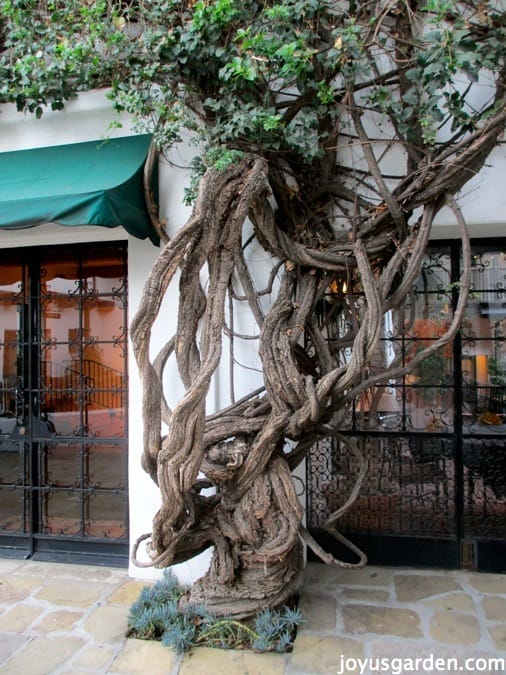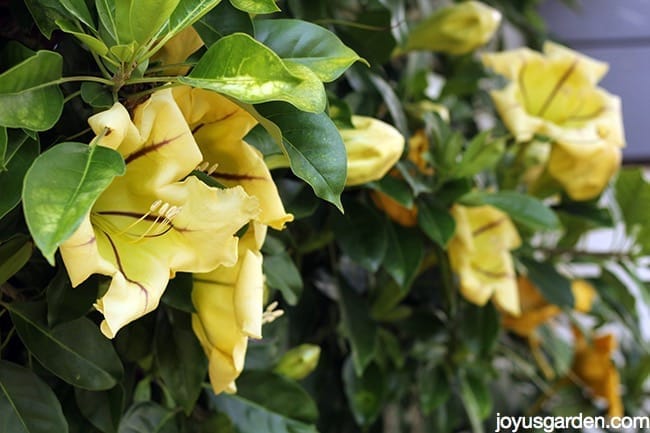Red Trumpet Vine
Distictis buccinatoria, commonly known as Red Trumpet Vine, Blood Red Trumpet Vine or Scarlet Trumpet Vine, is not for the horticulturally faint of heart nor those who detest pruning. This fast growing climber can reach up to at least 30′-40′ and has tendrils that grab onto anything it in its path. It will attach on to you if you stand still long enough! In other words, do not plan on using a flimsy trellis or single single stake for this plant – it needs a heavy means of support and lots of room to grow.
You’ll know what I mean when you look at the photo below. You can see how large the trunk of the trumpet vine can get as it ages. The form of the trunk is beautiful as it gnarls and twists its way up the wall.
This ain’t no young’un!
Here’s that same plant which as you can see climbs up and across the building and then down the stair railing all the way to the bottom. And yes, this vine does get pruned on a regular basis otherwise the stairs themselves would be completely covered with that glossy green foliage.
This is beautiful against the white walls when in flower
Speaking of pruning, I’ll tell you what I did to keep the Trumpet Vines I used to maintain in check when I was a professional gardener. In particular I’m going to refer to one that was growing on a long length of wooden fence in San Francisco and had to be pruned regularly to keep it from smothering a large camellia and the neighbor’s privet hedge. This was a very old vine and not the best place for it (it wasn’t planted by me) as it was maintenance intensive.
Here the Red Trumpet Vine covers, along with a Lavender Trumpet vine, a wall and the sides of 2 buildings downtown in Santa Barbara
This is what I did and it worked well. I would give it a good hard pruning in the Spring to set the shape and to keep it from going crazy. Then, every month I would prune off the stems that wanted to climb into and take over the surroundings plants. In late Fall, it would get another good pruning although not as hard as the one in Spring. The newer growth is really soft and easy to cut by the way. For the Spring pruning, I would also use lopers and a pruning saw.
As you can see here, it can be pruned and shaped – this does take maintenance!
This is a great use for this vine. It is planted on a very long length of chain link fence & hides the railroad tracks on the other side
Looking inside of a Podocarpus you can see how tangled the vine gets. Some alive, some dead
This poor podocarpus was completely smothered until the city cut the vine. As you can see, the dead remains because it has attached itself
As far as conditions go, Red Trumpet Vine needs sun, loves heat and flowers heaviest in the warmer months. Other months, the bloom is constant but much lighter. It likes well drained soil and prefers a regular, deep watering. After established, it is fairly drought tolerant. Much of it growing around town here in Santa Barbara gets no supplemental water at all. This year we’ve had no rain for almost 8 months now and this vine still grows like crazy.
The lovely red flowers are the other draw of this plant, along with its glossy green foliage. It tends to flower in clusters and as you can imagine, hummingbirds adore it.
The tubular,red flowers make it a hummingbird’s delight
Here it happily competes with Star Jasmine (also loved by hummingbirds) for wall space
To sum it all up, this is a really beautiful plant but danger can lay ahead Will Rogers – it needs the right spot with a lot of room to grow. The picture below says it all – a tractor left parked on the other side of the chain link fence bordering the train tracks is slowly becoming covered. Red Trumpet Vine is definitely a clinger!

This post may contain affiliate links, you can read our policies here.
- About the Author
- Latest Posts
Nell, the founder of Joy Us garden, was born into a gardening family and grew up in Connecticut’s countryside. After living in Boston, New York, San Francisco, & Santa Barbara, she now calls the Arizona desert home. She studied horticulture & garden design, working in the field all her life. Nell is a gardener, designer, blogger, Youtube creator, & author. She’s been gardening for a very long time & wants to share what she’s learned with you.


















The trumpet vine is one of the best ways to insure that your garden will be full of hummingbirds !
So true Teddy … & who doesn’t want hummingbirds in their garden?!
Is there a danger of the roots becoming invasive and popping up in different places? I just pruned mine way back and am concerned that it might react this way.
Also mine doesn’t flower much, and hummingbirds don’t use it. Ian positive this is the right ID for my plant. Thank you!
Hi Merry – With the Distictis buccinatoria the vine gets really big as does the trunk. With the Campsis radicans, the vine spreads by underground runners & can become somewhat invasive. Nell
Hi now-I am planning on planting this vine on a strong trellis between a sidewalk and my garage. I don’t want it to damage my sidewalk.-I read that it can be better contained by planting it in a 5 gallon plastic bucket with the bottom cut out. Do you think that would be a useful plan ?
Hi Lisa – The Red Trumpet Vine I’m writing about is Distictus buccinatoria which is the evergreen one. It’s a very vigorously growing vine but I’ve never seen it damage sidewalks or foundations. The only damage I’ve seen it do was to a wooden fence which had most likely weakened over time. The Campsis trumpet vines can damage structures. Nell
It`s so wonderfull, here in Brazil we don`t have this Distictis buccinatoria. I searched everywhere.
Hi Carlos – I’m surprised because the climates are very similar. It’s a beautiful but very vigorous vine so it’s best to have the room to let it take off. Flowers almost all year long & the hummingbirds love it! Nell
I want to choose such a lovely flowering climber as this to put in a now empty pot 50cm x30cm to climb up our wall outside our kitchen.
Would it work well in a pot or would you recommend the ground only please?
Hi Alison – Because trumpet vine (distictis) is such a strong & vigorous growing vine which reaches heights of around 30′, it’s best to grow it in the ground. It actually forms a trunk over time. Nell